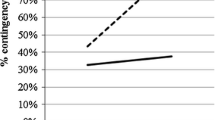Abstract
By manipulating the facilitator's knowledge of a student's just-completed activity, facilitated communication ability and the extent of guiding were assessed. Seven students diagnosed with mental retardation and their facilitators participated in the study. All 7 students were purported at the start of the study to be communicating via facilitation at levels far above what was previously thought possible given their level of intellectual ability. A large degree of facilitator guiding was revealed for each of the 4 facilitators. Minimal evidence of facilitation was found for 4 of the 7 students. One of the 7 students demonstrated validated facilitated communication on two trials.
Similar content being viewed by others
References
Biklen, D. (1990). Communication unbound: Autism and praxis.Harvard Educational Review, 60, 291–314.
Biklen, D. (1992). Typing to talk: Facilitated communication.American Journal of Speech and Language Pathology, 2, 15–17, 21–22.
Biklen, D. (1993).Communication unbound. New York: Teachers College Press.
Biklen, D., Morton, M. W., Saha, S. N., Duncan, J., Gold, D., Hardardottir, M., Karna, E., O'Connor, S., & Rao, S. (1991). “I AMN NOT A UTISTIVC OH THJE TYP” (“I'm not autistic on the typewriter”).Disability, Handicap & Society, 6, 161–180.
Biklen, D., & Schubert, A. (1991). New words: The communication of students with autism.Remedial and Special Education, 12, 46–57.
The Crestwood Company. (1993).Crestalk Milwaukee, WI.
Cummins, R. A., & Prior, M. P. (1992). Autism and assisted communication: A response to Biklen.Harvard Educational Review, 62, 228–241.
Green, G. (1992, October).Facilitated communication: Scientific and ethical issues. Paper presented at the Shriver Center UAP Research Colloquium, Waltham, MA.
Hudson, A., Melita, B., & Arnold, N. (1993). Brief report: A case study assessing the validity of facilitated communication.Journal of Autism and Developmental Disorders, 23, 165–173.
Kurtz, A. (1992, March). Testing for validity.New England Newsletter on Facilitated Communication, 1.
Moore, S., Donovan, B., & Hudson, A. (1993). Brief report: Facilitator-suggested conversational evaluation of facilitated communication.Journal of Autism and Developmental Disorders, 23, 541–552.
Moore, S., Donovan, B., Hudson, A., Dykstra, J., & Lawrence, J. (1993). Brief report: Evaluation of eight case studies of facilitated communication.Journal of Autism and Developmental Disorders, 23, 531–539.
Wheeler, D. L., Jacobson, J. W., Paglieri, R. A., & Schwartz, A. A. (1992).An experimental assessment of facilitated communication (TR #92-TA1). Schenectady, NY: O. D. Heck/ER DDSO.
Wheeler, D. L., Jacobson, J. W., Paglieri, R. A., & Schwartz, A. A. (1993). An experimental assessment of facilitated communication.Mental Retardation, 31, 49–60.
Wolfensberger, W. (1992, August/October). The facilitated communication craze: The cold fusion of human services.Training Institute Publication Series, p. 39.
Author information
Authors and Affiliations
Additional information
We gratefully acknowledge the assistance of Sherrie Schlecker and Carole Nebhut who served as judges. We express our thanks to Joyce Lentz for assistance in literature review. Douglas Wheeler was kind enough to make available to us his file of unpublished research studies. Marvin Rosen assisted in the initial design phase of the study. We are especially grateful to the students and staff who participated in this study. This study was supported by Elwyn, Inc.
Rights and permissions
About this article
Cite this article
Simon, E.W., Toll, D.M. & Whitehair, P.M. A naturalistic approach to the validation of facilitated communication. J Autism Dev Disord 24, 647–657 (1994). https://doi.org/10.1007/BF02172144
Issue Date:
DOI: https://doi.org/10.1007/BF02172144




